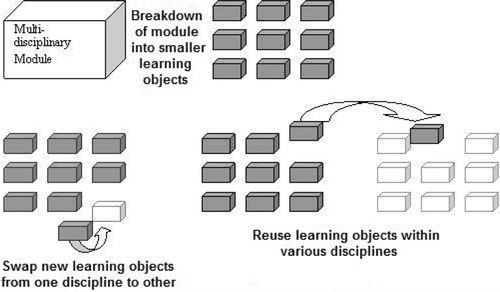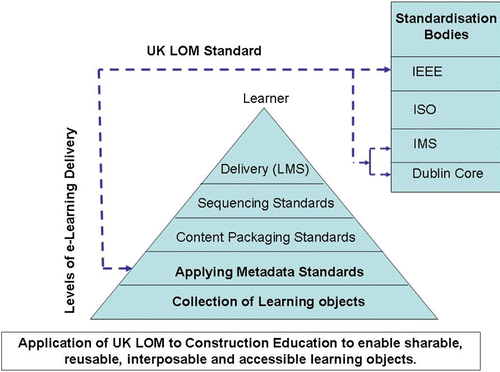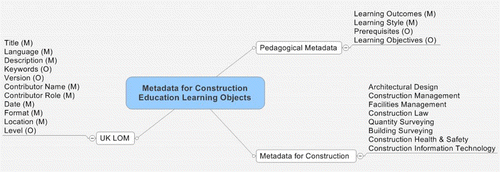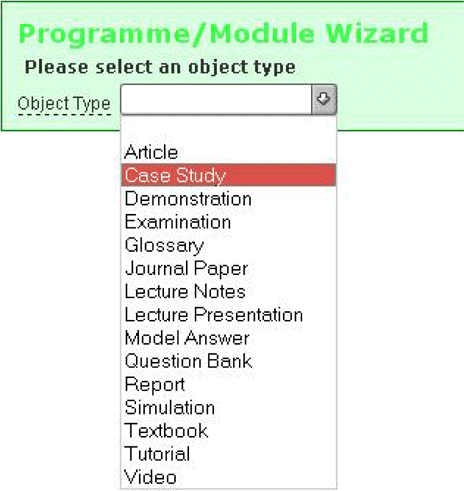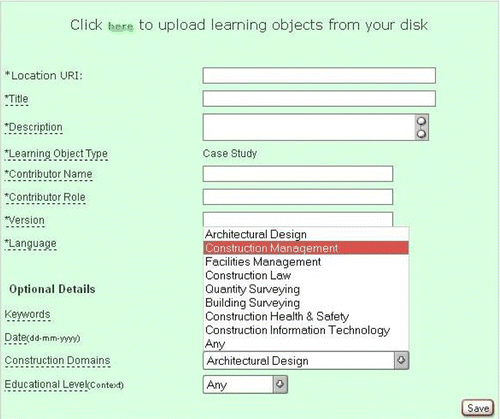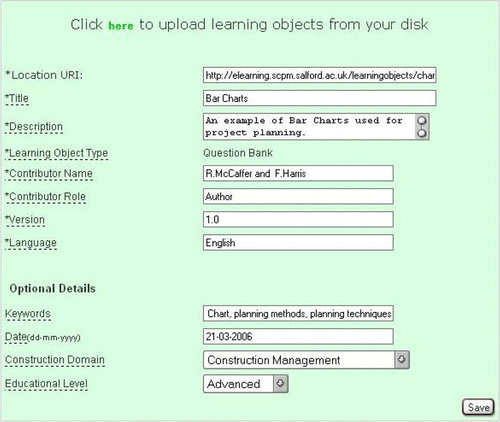Abstract
E-learning has occurred in the academic world in different forms since the early 1990s. Its use varies from interactive multimedia tools and simulation environments to static resources within learning management systems. E-learning tools and environments are no longer criticised for their lack of use in higher education in general and within the construction domain in particular. The main criticism, however, is that of reinventing the wheel in order to create new learning environments that cater for different educational needs. Therefore, sharing educational content has become the focus of current research, taking e-learning into a whole new era of developments. This era is enabled by the emergence of new technologies (online and wireless) and the development of educational standards, such as SCORM (Sharable Content Object Reference Model) and LOM (Learning Object Metadata) for example. Accordingly, the broad definition of the construction domain and the interlocking nature of subjects taught within this domain, makes the concept of sharing content most appealing.
This paper proposes a framework developed to describe the various steps required in order to enable the application of e-learning metadata standards and ontology for sharable learning objects to serve the construction discipline. The paper further describes the application of the proposed framework to a case study for developing an online environment for learning objects that are standardised, sharable, transparent and that cater for the needs of learners, educators and curricula developers in Construction Management. Based on the framework, a learning objects repository is developed incorporating educational and web standards. The repository manages objects as well as metadata using ontology and offers a set of services such as storing, retrieving and searching of learning objects using Semantic Web technologies. Thus, it increases the reusability, sharability and interoperability of learning objects.
Introduction
According to CitationKhan (2001), e-learning can be viewed as an innovative approach for delivering a well designed, learner-centred, interactive, and facilitated learning environment to anyone, anywhere, anytime by utilising the attributes and resources of various digital technologies along with other forms of learning materials suited for an open, flexible, and distributed learning environment.
The instruction methods used within construction education rely on traditional methods such as exposing students to applied science courses (CitationPark et al., 2003). These traditional teaching methods, however, are often not fully capable of providing students with all the skills necessary to solve the real world problems encountered in construction, or conveying complex engineering knowledge effectively. The curricula, however, often conveys fragmented knowledge in a series of courses.
Ideally, visits to construction sites or site training would constantly complement the more conventional classroom instructional tools. However, there are various complicating issues that make it impossible to rely on the construction sites. Firstly, the instructor cannot control the availability of a project at the necessary stage of completion. Secondly, visits of larger groups to construction sites may not be welcome, involve risk, and are impractical. The high cost of site training is a further impediment to its extensive use for construction education.
The implementation of e-learning into construction education had a slow start, but is catching up with other fields. During the 1990s a number of UK initiatives were launched to support the development and integration of e-learning within higher education. This process can be summarised in three phases: Phase 1 (1992–1996) formed the era of stand alone applications; Phase 2 (1996–1998) the generic ‘online’ application phase; while Phase 3 (1998 – Present) moved towards Web-based and Wireless Mobile learning. Presently a major focus is in web-based learning (e-learning) and this is slowly and steadily moving towards mobile learning (m-learning) (CitationNoessel, 2003) even though the cost of its implementation is a bit of a hindrance (CitationTraxler, 2003).
The Joint Information System Committee (JISC) also funded a number of similar initiatives to look into e-learning standards to bridge content and systems. Since then, the development of e-learning tools for construction education has been continuously growing. Their development, however, is costly and time consuming and they soon become out of date. This is mainly because of the fast changes in the technology and their incompatibility with new systems or platforms, and as a result of available instructional software being locally effective but globally fragmentary (CitationMolyneux, 2002).
Educators must also learn to teach in the context of new pedagogical models and to use online tools so that they can perform the core of their job more effectively, efficiently and with more appreciation (CitationKoper, 2004). Educational systems must be flexible in that they must be easy to adapt to new and changing user requirements. The state-of—the-art way of dealing with open requirements is to build systems out of reusable components to a plug-in architecture (CitationEl-Saddik et al., 2000). The functionality of such systems can be changed or extended by substituting or plugging in new components. Although the component-based solutions developed to date are useful, they are inadequate for those building component-based interactive learning environments in which the components must respond to the meaning of the content as well as its form and representation. Construction educators and technologists must take the lead in promoting computer literacy in their curriculum and continue to develop new courses, delivery styles and software applications through continued research activities (CitationBerryman et al., 2004).
On the other hand, educational software has been developed with the potential for online learning as complete packages, commercially prepared and disseminated. However, they lack cohesion as an organised collection because every software application is vertically engineered to comply within its specific domain. This makes their reusability and sharing more difficult and can lead to maintenance and deployment difficulties as restrictive platform requirements accumulate over time. This paper develops an understanding of standardisation of e-learning and related concepts which underpins the theory behind developing an online environment for sharable learning objects, with a particular focus on a case study for sharable learning objects in Construction Management.
Learning Objects
The aim of creating learning objects is to achieve the goal of maximum reusability, leveraging the high cost of production of quality materials without sacrificing the learning meaning. The concept of a learning object emerges from the need to introduce and elaborate e-learning content with pedagogical aspects in a way that can be reused in different learning scenarios.
The Institute of Electrical and Electronic Engineering (IEEE) Learning Technology Standards Committee (LTSC) defines learning objects as “any entity, digital or non-digital, which can be used, re-used or referenced during technology supported learning” (CitationLOM, 2003). It also suggests that a learning object can be of a multimedia content, instructional content, learning objectives, instructional software and software tools, persons, organisations, or events referenced during technology supported learning. Although the LTSC definition is too broad to actually define a learning object, CitationWiley (2000) defines a learning object as “any digital resource that can be reused to support learning”. This definition includes anything that can be delivered across the network on demand, be it large or small. below demonstrates the concept of learning objects that can be reused and swapped between different modules of learning and within different disciplines.
However, in order to be able to exchange, share and integrate learning objects within different learning environments in general, and for the construction discipline in particular, it is important to develop an understanding of learning standards for sharable learning objects. The following section describes the educational learning standards currently available and identifies the most suitable standards that can be adopted to develop the sharable learning objects repository for construction education.
E-Learning Standards
The development of e-learning content is often expensive and time consuming. Curriculum developers tend to reinvent the wheel as they find it difficult to locate the learning materials to reuse within the e-learning systems. Learners often face problems in discovering learning materials they need. Learning content developed for a learning management system may only be used within the system itself. Therefore, learning content needs to be interoperable with different learning environments and produced in a standardised way to maximise its reusability. Since many learning materials and learning management systems lack interoperability with other systems, there is a need for standards to be used in e-learning. CitationAhmed and Shaik (2004) argue that standardisation using learning standards is the ultimate solution to achieve interoperability in e-learning. Learning standards provide standardised data structures and communication protocols for learning materials and learning management systems. Learning standards are technical protocols, which promote easy exchange of content or data between different systems based on different technologies.
Learning content has to be labelled in a consistent way to be discovered by various search engines. It also needs to be packaged in a standardised way to be delivered to different learning systems. Therefore, there is a need for the standardising and labelling of learning objects by using metadata and packaging standards. There are, however, different types of standards that exist for these purposes which can be classified into some general categories for the delivery of e-learning objects. This paper is focused on the understanding of metadata standards and their integration within a learning objects repository for sharing content. Learning Object Metadata is referred to as the labelling of learning objects so that they can be identified via search engines (CitationQin and Hernandez, 2004).
shows the stages for the delivery of learning objects to Learning Management Systems (LMS) so that objects can be accessed and managed by educators to meet the needs. There are a number of standardisation bodies that are in the process of creating metadata standards; for example, the IEEE Learning Technology Standards Committee produced a standard called Learning Object Metadata standard (CitationLOM, 2003). The Dublin Core Metadata Initiative also developed a different metadata standard with less elements compared to IEEE LOM. The Dublin Core Metadata Initiative is widely used by libraries, publishers and government organisations. The IMS Global Learning Consortium and the Advanced Distributed Learning Initiative (ADL) have adopted IEEE LOM as their metadata standard. ADL’s SCORM (Sharable Content Object Reference Model) specification uses IEEE LOM standard for packaging learning objects as deliverable content (CitationLOM, 2003).
The rest of this paper describes a strategy for developing an online learning object repository by identifying the most suitable metadata standards that can be integrated to share educational content within construction. The paper will also propose a metadata framework that will be validated through its application to a construction project management module.
Towards The Development of an Online Repository for Learning Objects
The aim of the online learning repository is to develop an environment for learning objects that are interoperable, transparent and sharable by the community of educators and learners within the construction discipline and to be accessible anywhere, any time. shows a conceptual framework that describes the rationale behind the research.
Based on the above, there are three main challenges that face such developments to produce learning objects that are:
Intelligent by developing ‘relational metadata’,
Accessible through various learning environments via content packaging, and
Dynamic using ontologies and the semantic web concepts.
To meet these challenges shows the methodological steps for producing the online repository which include:
Stage 1: Developing a metadata framework which integrates the most suitable metadata as well as proposed pedagogical and construction metadata elements which can be applied to a multimedia of learning objects.
Stage 2: To apply a content packaging standard that packages learning objects so they can be posted to and retrieved from various learning management systems such as Blackboard and WebCT and delivered via mobile technologies.
Stage 3: To identify the ontology (i.e. a common vocabulary of terms and concepts) for construction education and to develop a semantic web environment that will increase sharability of objects within construction domains.
shows the methodological framework for the development of the proposed online Learning Object repository.
The main focus of this paper is on Stage 1 of the methodological steps highlighted above, which forms the initial steps towards developing an online repository using the Semantic Web concepts.
Metadata for the Online Repository of Learning Objects
Adopting UK LOM standard
The UK LOM Core is an application profile of the IEEE Standard for Learning Object Metadata that has been optimised for use within the context of UK education (CitationUK LOM, 2004). Therefore to develop an online repository of learning objects, the UK LOM metadata elements (of which 44 are optional and 42 are mandatory) were studied. Not all these elements, however, are found essential to identify learning objects via the search engine within the online repository. Therefore, in order to identify the most relevant metadata elements that can be generically used, a pilot survey was conducted. Twenty participants took part in this survey, giving different rankings to the most relevant elements. The most relevant of these elements can be seen in . The table also shows the definition of each element as originally identified by IEEE LOM.
Table 1 Most relevant metadata elements identified by a pilot survey
The application of this metadata is applied to the “Case Study for Construction Project Management” as described later in the paper.
Defining Metadata for Construction
In order to define the metadata tagging for the construction discipline, it is important to define the construction domains and to do so, an extensive literature review was carried out. However, due to the complex nature of the construction industry, the definitions of terms clashed depending on the subject expert’s expertise. Therefore a number of construction websites, conference websites, professional bodies and other sources of information were visited to identify the domains and sub-domains within this discipline. , below, compiles a summary of these domains and their most related entities.
Table 2 Identified construction domains and related entities
The literature also revealed that there is no metadata that defines construction domains in order to make searchable learning objects construction specific. Therefore the above domain metadata will be integrated within the online repository to demonstrate how the construction related learning objects can be standardised.
Defining Pedagogical Metadata
The pedagogical metadata was captured from a standard ‘Module Specification Form’ which follows the QAA guidelines for curricula development as shown in with their description. The table also shows learning styles as an additional metadata, which has been a subject of academic debate for some time (CitationAhmed, 2000).
Table 3 Pedagogical metadata
To test the importance of such metadata, a sample of educationalists and learners was surveyed and twenty responses were obtained. The surveyed participants were asked to state which of the pedagogical metadata to be defined was ‘most important’, ‘relevant’ or ‘not important’. The results of this survey are summarised in , below, whereby 83% of the population felt that it is important that the learning objects state the learning outcome and 67% agreed to the same for learning styles. 65% felt that the pre-requisites of the learning object are relevant, and 77% thought that stating the learning objectives is not important. Based on these results, column four of shows that the elements with ‘important’ have been considered as mandatory ‘M’, and the ‘relevant’ and unimportant responses are considered as optional ‘O’.
Table 4 Responses for pedagogical elements
Such metadata will be integrated within the online repository to form the pedagogical aspects of learning objects.
Defining Metadata for Learning Styles
According to CitationKolb (1984), Honey & Mumford (1982) and CitationRiding & Cheema (1991), individuals have different learning styles which are dictated by a number of factors, including their social interaction, academic and work experience. As a result CitationAhmed (2000) addressed the need for considering an individual’s learning styles when delivering learning content. Based on such findings, the learning objects are addressed by their suitability to match various learning styles. Riding and Sadler-Smith’s learning style analysis (CitationRiding and Sadler-Smith, 1997) address two types of learners; those who are “verbalisers” (i.e. they learn best from abstract concepts), and those who are “imagers” (i.e. they learn best from visual content) as shown in . These styles were found to be a simple and easy way of associating learning styles to suit learner’s preferences and are used as metadata for the learning objects.
Table 5 Proposed learning styles metadata
This learning style metadata will be integrated within the learning objects to demonstrate the most suitable mode of delivery for end users.
Defining the types of Learning Objects
The literature shows that types of learning objects are classified differently by various standardisation bodies. IEEE LOM v1.0 vocabulary is problematic as it includes terms that describe both the form (e.g. diagram) and the function (e.g exam) of the object (CitationUK LOM, 2004). In recognition of this, many application profiles recommend the use of customised vocabularies to describe this element.
A range of UK and European learning object type vocabularies are compared in order to find a suitable vocabulary for the online learning objects repository. A comparison between the IEEE LOM and RDN/LTSN (CitationLearning and Teaching Support Network, 2003) learning object types was made and summarised in .
Table 6 Comparison between UK LOM and RDN/LTSN learning object types
These definitions were tested via a pilot survey which was distributed to a sample of twenty people in order to establish the most common definitions that end users’ identify with. The results of this survey revealed that the object types that are shown in are most recognised.
Based on these findings, this research will adopt the definitions summarised in to identify the type of learning objects and their media. The following keys identify the type of media for each object [■ Audio, ○ Video, ● Abstract, ^ images, * animation].
Table 7 Learning objects and their media
The findings from this section are integrated to produce a generic framework for developing metadata in construction education.
The study of UK LOM metadata standard, metadata for construction and the pedagogical metadata has led to the development of a generic framework for the integration of metadata for construction education as shown in below.
This framework will be adopted to develop the metadata for a learning object repository that can be used for sharing and exchanging learning objects that are transparent and interoperable. To validate and test this framework, the following section identifies Construction Project Management as a domain within the construction discipline and Project Management as a module taught within this programme of study to share and exchange learning objects.
Learning Objects for Construction Management — A Case Study
The construction discipline is complicated by its nature, as it consists of a number of domains that are closely interlinked. The knowledge of one domain requires some knowledge of another. This often adds pressure on curriculum developers to introduce modules that can be taught across different programmes of study. demonstrates a model of a number of programmes delivered within the School of the Built Environment at the University of Salford, including Construction Project Management. ‘Project Management’ is one of the generic modules taught across programmes such as Quantity Surveying and Building Surveying. This module provides a number of learning outcomes that relate to various domains within the construction field. It requires the teaching of organisational management, the role of the project team, risk management and quality control aspects: in other words, the management of projects from the inception to the handover stage. The content of this module can be a source of information at different levels. At this stage, sharing and interchanging of content in a form of learning objects becomes very useful and the adoption of metadata becomes important. below, demonstrates how a learning object can belong to a number of topics from different modules, while these modules belong to different programmes. Based on such principles and the generic metadata framework proposed in , this case study demonstrates the development of ontology for learning objects that could be submitted in a standardised manner to the online learning objects repository.
This section shows the output of mapping the metadata framework for the development of the online digital repository which forms stage 1 of the development of the online environment.
The following steps demonstrate how the metadata, developed as a part of the generic framework, is integrated within the online environment whereby end users will be able to follow these steps to submit and retrieve learning objects.
Step 1
shows how the learning object types identified earlier in this paper are integrated within the environment. It lists all the learning object types as a drop down menu so that the end users can select the appropriate type of their learning object. When they make a choice, the system will take them to the next step.
Step 2
shows how the pedagogical metadata such as ‘Learning Styles’ is integrated within the system. The Learning Object types are associated with Learning Styles that suit the needs of various learners. This will enable the end users to select an object that suits their learning style as an optional choice.
When the learning style is selected the system will take the user to the next step in order to select an appropriate programme, module and topic to identify the Learning Object required.
Step 3
The programme structure is developed using ontology where the complex relations and concepts, similar to the one shown in , are modelled. It gives users freedom of choice in navigating and selecting required components by hiding the complex relations. shows the navigation structure of the programmes where users are able to choose multiple modules and topics which are related to their learning object.
After choosing the pedagogical and structure details of the learning object, the system will take users to the next step where the learning object is labelled using the proposed metadata.
Step 4
demonstrates various construction domains as a result of integrating construction metadata in the interface. This enables end users to select the appropriate domain according to their learning object. For the purpose of this case study the construction management domain is selected.
Step 5
In this step, the learning object will be labelled using the metadata proposed earlier. shows an example of metadata built into an object to complete the metadata form shown in , and presented as raw data.
Table 8 Example metadata
The labelling of the above metadata onto a learning object is done using a form template as shown in . It demonstrates the direct entries to the interface using the same example adopting UK LOM metadata standard as proposed earlier. The stars (*) next to each metadata enquiry indicate that these are mandatory entries and the users will not be able to proceed without filling in these fields.
This paper covers the approach adopted to select the metadata standard for construction education learning objects. It demonstrated the approaches we used to identify the relevant metadata from UK LOM standard and to propose pedagogical and construction metadata. We finally demonstrated how the proposed metadata framework for construction education is integrated within the online environment that we are developing.
Based on the findings discussed in this paper, the metadata for the online repository has been produced. The second research challenge lies in the development of a relational metadata to make the learning objects dynamic, using the semantic web concepts.
Summary of Findings and Future Research
This paper described the main concepts behind the development of standardised learning objects and the type of metadata required for the development of an online repository of learning objects that can be intelligently searched, submitted and retrieved. The proposed generic metadata framework is validated through its application to a case study aimed at the development of an online repository of learning object for construction management. Such findings form stage 1 of the research outputs. Future work will focus on the technical aspects of the research which will enable the learning objects to be packaged as content that can be delivered to online Learning Management Systems (LMS), enabling the end users to manage the learning process according to their individual needs. The learning objects will be packaged as a compressed file using content packaging standard called SCORM (Sharable Content Object Reference Mode). Content packages will consist of learning objects and the information about how these learning objects can be put together to form learning modules. The online repository will use SCORM which will allow content to be transported from one learning management system to another by providing an API (Application Programming Interface) in order to hide LMSs’ implementation details from sharable content objects. Thus it notably promotes the reusability and interoperability of learning objects.
References
- Ahmed V. (2000). The effectiveness of computer aided learning in construction. Unpublished PhD thesis, Loughborough University.
- Ahmed V. & Shaik A. (2004). Learning objects: A new approach to e-learning in construction. Presented at: International Engineering Education Conference, Wolverhampton, UK, June.
- Berryman C. W., Fischer B. & Wentz T. (2004). Distance Education with Internet2 Audio/Video Technology. The International Journal of Construction Education and Research, 1 (1), 45-60.
- El-Saddik A., Fischer S. & Steinmetz R. (2000). ITBeankit: An educational middleware framework for bridging software technology and education. In Bourdeau J. & Heller R. Proceedings of ED-MEDIA 2000 World Conference on Education Multimedia, Hypermedia and Telecommunications, held in Montreal, Canada. pp. 1323-1324.
- Honey P. & Mumford A. (1992). The Manual of Learning Styles. Maidenhead: Peter Honey Publications.
- Khan B. H. (2001). Web Based Training. Englewood Cliffs, NJ: Educational Technology Publications.
- Kolb D. A. (1984). Experiential Learning: Experience as the source of learning and development. Englewood Cliffs, NJ: Prentice-Hall.
- Koper R. (2004). Use of the semantic web to solve some basic problems in education. Journal of Interactive Media in Education, Special Issue on the Educational Semantic Web (online). URL: www-jime.open.ac.uk/2004/1/
- Learning and Teaching Support Network. (2003). RDN/LTSN LOM Application Profile. URL: http://www.rdn.ac.uk/publications/rdn-ltsn/types/.
- LOM. (2003). Learning Object Metadata (online). URL: http://ltsc.ieee.org/wg12/.
- Molyneux S. (2002). The Future of e-Learning. Learning Lab Journal, 1 (3), 4-5 (online). URL: http://www.learninglab.org.uk/Journals/LearningLabJournal_vol1_issue3.pdf
- Noessel C. (2003). Mobile learning as service offering with near-term technologies. In: Proceedings of the 2nd annual MLEARN conference, MLEARN 2003, held at Inmarsat, London, 117-126 (online). URL: http://www.lsda.org.uk/events/mlearn2003/
- Park M., Chan S. & Ingawale-Verma Y. (2003). Three success factors for simulation based construction education. Journal of Construction Education, 8 (2), 101-114.
- Qin J. & Hernandez N. (2004). Ontological representation of learning objects: Building interoperable vocabulary and structures. In Feldman S. I. Proceedings of the 13th International Conference on World Wide Web, WWW 2004, New York: ACM Press, 348-349.
- Riding R. & Cheema I. (1991). Cognitive styles — an overview and integration. Educational Psychology, 11 (3-4), 193-215.
- Riding R. & Sadler-Smith E. (1997). Cognitive style and learning strategies: Some implications for training design. International Journal of Training and Development, 1, 199-208.
- Traxler J. (2003). Mobile learning as service offering with near-term technologies. In: Proceedings of the 2nd annual MLEARN conference, MLEARN 2003, held at Inmarsat, London, 183-188 (online). URL: http://www.lsda.org.uk/events/mlearn2003/
- UK LOM. (2004). UK Learning Object Metadata Core Draft v2.0. URL: http://zope.cetis.ac.uk/profiles/uklomcore
- Wiley D. A. (2000). Connecting learning objects to instructional design theory: A definition, a metaphor, and a taxonomy. In Wiley D. A. (Ed.). The instructional use of learning objects (online version). URL: http://reusability.org/read/chapters/wiley.doc (accessed 14 December 2005).
